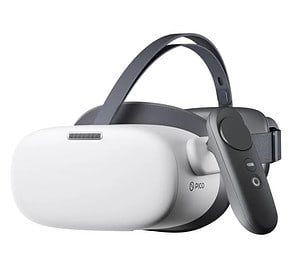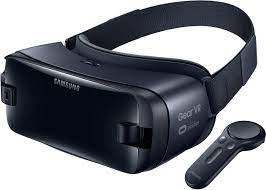

3 DOF (Degrees of Freedom) and 6 DOF are terms that refer to the freedom of movement of a VR headset.
A virtual reality headset with 3 DOF only captures the rotations of the user's head around the Pitch, Yaw and Roll axes. This means that the user can tilt their head up and down, turn left and right, and tilt their head to the side. The headset is not able to detect if the user is walking or leaning forward or backward. A virtual reality headset with 3 DOF can be used in situations where the user is primarily performing static or sedentary activities that do not require movement around the room. It is also beneficial when providing seating to show content that only allows rotation tracking.
Popular 3DOF headsets on the market: Current VR headsets in this category are Pico G2 and Pico G3

Older models like the Oculus Go are no longer sold, but are still used for presentations and trade shows.
Lower acquisition costs: 3 DOF headsets are generally much cheaper than headsets that enable position tracking, but the costs of 6DOF headsets are also falling steadily. An example of this is the Quest 3S.
Less space required: Without position tracking, 3DOF headsets do not require a special room or special sensors. This makes them ideal for situations where space is limited or movement is not possible, such as when sitting on an airplane.
Less battery consumption: Since 3DOF headsets require fewer sensors and processing power, they may consume less power and last longer than 6DOF headsets.
Simpler setup: Without external sensors or base stations, 3DOF systems are often less complicated to set up.
Portability: Many 3DOF headsets are lighter and more compact, making them more portable. This is ideal for use on the go or for quick VR sessions without much preparation.would be for example:
Applications for 3DOF headsets
here are examples of applications that also run best on 3DOF VR glasses.

Google Cardboard - The cheap 3DOF "headset
Another product in the smartphone VR headset category is the Google Cardboard. you can argue whether this is a headset or rather a gimmick. As the name suggests, this headset is mainly made of cardboard and serves as a simple and extremely inexpensive introduction to the VR world. Users fold the Cardboard into the right shape, insert their smartphone and use the Google Cardboard app to experience various VR experiences. The VR apps are iOS or Android apps from their respective app stores that support a Cardboard function. Despite its democratic approach to making VR accessible to everyone, the Google Cardboard has some significant weaknesses that significantly reduce its quality compared to other VR solutions:
Poor material: The cardboard material does not provide the durability or comfort of professionally manufactured plastic or cloth headsets. It can be easily damaged and is not ideal for extended periods of use.
No specialized hardware: The Cardboard relies entirely on the smartphone for both rendering and tracking. This means that there are no special sensors or controls that could improve the VR experience.
Simple lens design: The lenses in the Google Cardboard are not as high-quality or as accurately calibrated as those in more expensive headsets. This can lead to less clear pictures and possible distortions. Furthermore, the field of view is clearly restricted (tunnel vision).
Compatibility and fit: Because it is designed for a variety of smartphones, there is no one size or shape that is perfect for all devices. This may cause problems with the display or insertion of the smartphone.
All these weaknesses are probably the reason why the use of Cardboards as a presentation medium for VR content or 360° videos is declining strongly.
There have also been 3DOF VR headsets in the past that have more complex lenses and plastic housings. Examples of such products were the Samsung Gear VR and the Google Daydream View. Both are holders into which a compatible smartphone is inserted. The associated lenses of the headset then enlarge the image displayed on the smartphone so that it fills the user's entire viewing area.

Despite their simplicity and accessibility, these smartphone-based VR headsets cannot compete with standalone solutions in terms of quality.
| VR headset | DOF | Controller | Tracking | Price | Year of publication |
|---|---|---|---|---|---|
| Pico G3 | 3 DOF | Touchpad controller | Head tracking | ca.350€ | 2023 |
| Oculus Quest 2 | 6 DOF | Two touch controllers | Inside-Out Tracking | from approx. 350€ | 2020 |
| Pico 4 Enterprise | 6 DOF | Two touch controllers | Inside-Out Tracking | from approx. 600€ | 2022 |
| Meta Quest pro | 6 DOF | Two touch controllers | Inside-Out Tracking | from approx. 1200€ | 2022 |
| HTC Vive Cosmos Elite | 6 DOF | Two SteamVR controllers | Lighthouse tracking | from approx. 900€ | 2020 |
| Pico G2 | 3 DOF | Touchpad controller | Head tracking | ca.300€ | 2015 |
| Quest 3 | 6 DOF | Two touch controllers | Inside-Out Tracking | ca.580€ | 2023 |
| Quest 3S | 6 DOF | Two touch controllers | Inside-Out Tracking | ca.350€ | 2024 |
The era of 3DoF headsets that only offer rotation tracking is coming to an end. Thanks to modern devices such as the Meta Quest S, which offer both 6DoF tracking and hand tracking for just 350 euros, 3DoF headsets are technologically obsolete. They hardly offer any advantages anymore, as modern VR applications can no longer be used with them. It is likely that these headsets will soon disappear from the market as they no longer meet the requirements and price-performance ratio of modern alternatives.
For content such as 360° photos, films or simple presentations, 3 DoF is sufficient and resource-saving; headsets such as Google Cardboard or Pico G3 are inexpensive (< €350) and easy to use on the move
The price of 6 DoF is getting closer and closer: Headsets like Quest 3S deliver 6 DoF for under €400, outweighing the added value for most applications .
6 DoF allows complete position tracking (translation + rotation). You can physically move around the room, interact, grab virtual objects - essential for gaming, training or architectural scenarios in particular

Are you interested in developing a virtual reality or 360° tour application? You may still have questions about budget and implementation. Feel free to contact me.
I am looking forward to you
Clarence Dadson CEO Design4real